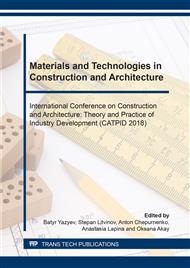[1]
Information on https://en.wikipedia.org/wiki/Burundi.
Google Scholar
[2]
Information on http://www.isteebu.bi/index.php/economie-en-bref.
Google Scholar
[3]
Information on: https://en.wikipedia.org/wiki/List_of_African_countries_by_population_density#cite_note-1.
Google Scholar
[4]
N. Faisol, A. R. J. Dainty, and A. D. F. Price, The concept of relational contracting as a tool for understanding inter-organizational relationships in construction, in: F. Khosrowshahi (Ed.), Proceedings 21st Annual ARCOM Conference, SOAS, University of London. Association of Researchers in Construction Management. 2, 7-9 September 2005, pp.1075-1084.
Google Scholar
[5]
Leonas Ustinovichius, Edita Šarkienė, The analysis of apartment house construction investments efficiency applying mathematical modelling, Proceedings of the 5th International Conference RelStat, (2005).
Google Scholar
[6]
A.A. Lapidus, P.A Govorukha, Organizational and technological potential of the enclosing structures of multi-storey residential buildings, MSCU Herald. 4 (2015) p.143–149.
Google Scholar
[7]
I. E. Fayzullin, Prospects of development of low-rise construction in the Republic of Tatarstan, Regional Economy - Theory and Practice. 30 (2010) pp.44-48.
Google Scholar
[8]
A.V. Kalabin, Typology of residential multi-storeyed buildings, small and medium: current status, Academic herald of Ural project RAASN. 1 (2014) p.63–69.
Google Scholar
[9]
K.A Cherepanov, Problems of choosing optimal building parameters depending on the social, economic and ecological properties of the urban environment, A Young Scientist. 2 (2014) pp.216-232.
Google Scholar
[10]
J. von Meding, D.S.N. Pg Maidi, J. Spillane, J. Bruen and R. McGrath, Critical success factors of construction project quality in brunei darussalam, in: The international conference on sustainable built environment for now and the future, March 26-27, 2012, Hanoi, Vietnam.
Google Scholar
[11]
Min Liu, Glenn Ballard, and William Ibbs, Work flow variation and labor productivity: Case study, Journal of management in engineering, ASCE. 27 (4) (October 2011).
DOI: 10.1061/(asce)me.1943-5479.0000056
Google Scholar
[12]
SIBOMANA Aimable, Jaya Shukla, Joseph Oduor, Effects of risk management methods on project performance in rwandan construction industry. A case study of multi-storey buildings construction project of RSSB, Jomo Kenyatta University of Agriculture and Technology, Kigali, Rwanda, (2015).
DOI: 10.21474/ijar01/1308
Google Scholar
[13]
A.A. Lapidus, T. Kh. Bidov, The efficiency potential of organizational, technological and managerial solutions for non-destructive quality control methods in the construction of monolithic reinforced concrete structures.in: International Journal of Applied Engineering Research. 11 (8) (2016).
Google Scholar
[14]
A.A. Lapidus, A.N. Makarov, Formation of the organizational and technological potential for the production of roof structures of residential multi-storeyed buildings, MSCU Herald. 8 (2015) pp.150-160.
Google Scholar


